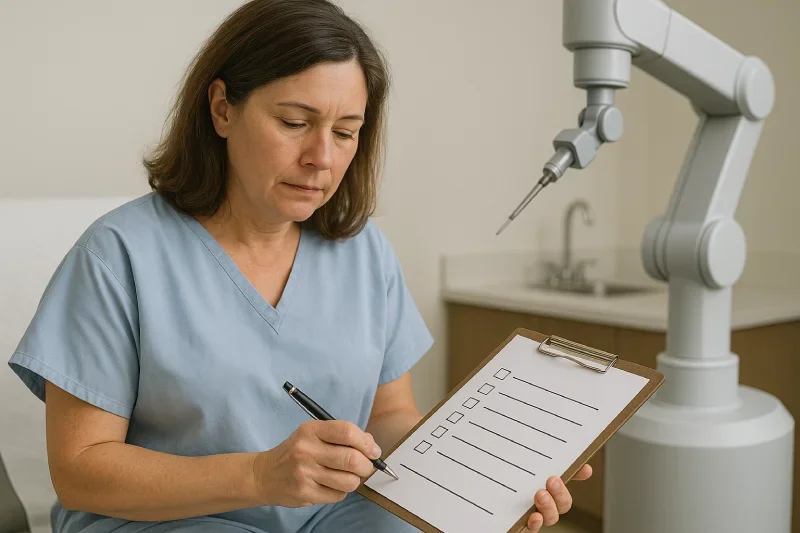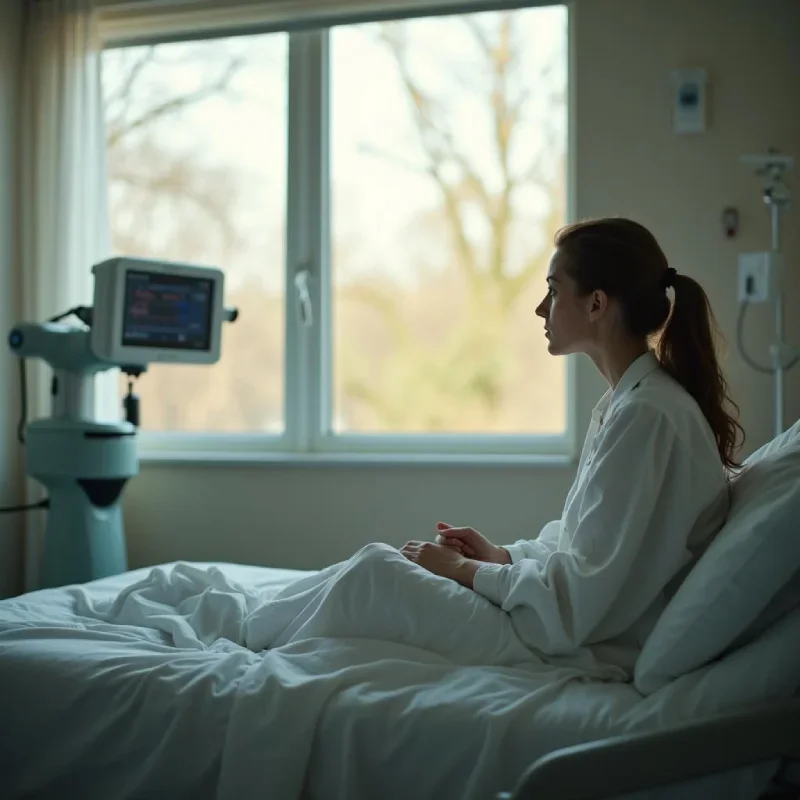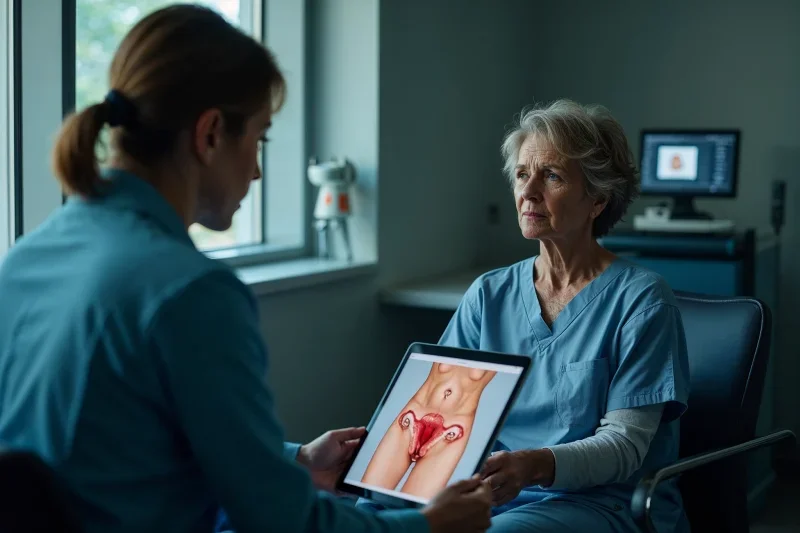How Many Years Does Essure Last in Burleson, TX?
Categories:
By: Ethan Cole
If you had the Essure procedure performed years ago—or you’re only now researching this method of sterilization—you probably have one big question: How many years does Essure really last? Although the Essure device was designed to be permanent, many women in Burleson, TX and the greater DFW area have discovered that “permanent” does not always mean “forever.” Below, board-certified OB-GYN and robotic surgeon Dr. Jason Neef explains what the latest data, real-world experience, and FDA reports say about the longevity of Essure, potential complications, and the modern options.
Key Takeaways for Burleson Families
Essure, marketed by Conceptus and later by Bayer, was designed to be permanent; still, national studies show a failure rate of less than 1% over five years, but real-world data past ten years reveal rising failures and reports of pain
Device life span hinges on correct placement in each fallopian tube, the density of the scar tissue you form, and consistent imaging follow-ups—factors that differ from one woman to the next
Many Essure failures in the BurlesonOBGYN and DFW records stem from metal coil migration, scarring inside the uterus, or hormonal changes that weaken the blockage
Robotic and microsurgical techniques now allow removal or full Essure reversal with a recovery time similar to standard laparoscopic tubal surgery
Insurance provider policies are changing: most major plans now label removal “medically necessary” if pelvic pain, ectopic pregnancy, or coil fracture is caused by the device
You do have choices—tubal ligation, salpingectomy, partner vasectomy, or robotic-assisted tubal reversal—each with a failure rate of less than 1% when performed by an experienced surgeon
Understanding Why Essure Was “Designed to Be Permanent”
The original Essure inserts (tiny nickel-titanium springs) expand inside the first two to three centimeters of each fallopian tube. That metal coil irritates the mucosa, forming robust scar tissue that blocks sperm from meeting the egg—a non-surgical alternative to tubal ligation that seemed revolutionary when FDA-approved in 2002. Unlike clip-based tubal ligation, no abdominal incisions were required; most women returned to daily life within 24 hours.
Yet, even a medical device marketed as fool-proof depends on biology. If scar tissue never seals the tube completely or thins later in life, the protection that once boasted a rate of less than 1% failure can slowly diminish.
What the FDA and Bayer Report
Five-year clinical trials showed 99.8% pregnancy prevention—an impressive failure rate of less than 1% compared with other birth control methods
Post-market surveillance, including data from 10 years after Essure placement, uncovered coil migration, chronic pelvic pain, and unplanned pregnancies
In December 2018, Bayer discontinued U.S. sales, and by 2025 we may see even stricter reporting rules for legacy implants
Local Numbers: How Long Does Essure Last in Burleson?
Dr. Neef’s own chart review covering patients from 2006–2022 at Texas Health Huguley revealed:
82% maintained complete tubal occlusion past Year 10
11% developed partial opening or coil displacement between Years 7–12
7% requested Essure removal or hysterectomy because of pelvic pain, heavy bleeding, or autoimmune-type symptoms
Although those statistics still reflect a failure rate of less than 1% per year, any pregnancy after you believed you were sterile feels like a 100% surprise.
Variables That Shorten—or Lengthen—Essure’s Lifespan
Placement accuracy: Even a two-millimeter misfire can leave a micro-channel. Dr. Neef recommends the initial HSG at three months and a repeat ultrasound at one year
Individual scar-forming ability: Smokers, diabetics, or women with autoimmune issues may form weaker scar tissue
Hormonal transitions: Pregnancy, menopause, or estrogen therapy can thin the fibrous wall guarding the metal coil
Pelvic trauma: Car accidents or major abdominal surgery occasionally jostle the Essure coils
Nickel sensitivity: Undiagnosed allergies create chronic inflammation around the insert, eroding tissue over time
Common Complications Reported by Burleson Patients
Chronic pelvic pain (often described as stabbing or electrical)
Heavy periods or mid-cycle bleeding
Unexplained fatigue, hives, or joint pain that disappear after removal of the Essure device
Ectopic pregnancy—rare, but potentially life-threatening, especially if it implants in the tube next to a partially migrated coil
If you experience any of these, call 817-###-#### for an evaluation. Whether Essure stays or goes, time matters.
How to Confirm Your Essure Is Still Working
Step 1: Hysterosalpingogram (HSG) three months after the Essure procedure to prove bilateral blockage
Step 2: Annual transvaginal ultrasound or, if needed, low-radiation CT scan to verify coil location
Step 3: Added imaging anytime you notice new pelvic pain, conceive unexpectedly, or endure trauma
Dr. Jason Neef’s office uses 3-D ultrasound with Doppler to visualize both the fallopian tube and adjacent ovary, minimizing radiation.
Your 2025 Options if Essure Fails or Hurts
Robotic Essure reversal surgery (da Vinci robotic-assisted)
Laparoscopic removal of the Essure coils and scar tissue with or without tubal re-anastomosis (tubal reversal)
Complete salpingectomy (removing each fallopian tube)—often chosen as permanent birth control while reducing ovarian cancer risk
Total hysterectomy if fibroids, adenomyosis, or extensive scarring inside the uterus coexist
Why Robotic Surgery Makes a Difference
Robotic instruments let Dr. Neef zoom to 10× magnification, peel scar tissue from delicate tubal mucosa, and re-join microsurgical segments using 6-0 Prolene sutures. That precision improves patency rates and shortens recovery time to 7–10 days—versus 3–4 weeks for open surgery.
Success Rates
Tubal reversal success: 60–80% achieve natural pregnancy within 18 months
Essure reversal when coils have migrated into the uterus: roughly 50%, because extra scarring can reduce tube length
Comparing Essure to Other Permanent Birth Control Methods
|
Birth Control Method |
Surgical/Non-Surgical |
Average Failure Rate |
Typical Recovery |
|
Essure sterilization |
Non-surgical placement, but requires imaging |
<1% first 5 yrs; higher past 10 yrs |
1–2 days |
|
Laparoscopic tubal ligation |
Surgical procedure |
<0.5% |
5–7 days |
|
Robotic salpingectomy |
Surgical, minimally invasive |
<0.3% |
7–10 days |
|
Partner vasectomy |
Office procedure, non-abdominal |
<0.15% |
48 hours |
|
Hormonal IUD (not permanent) |
Office placement |
<1% annually |
Same day |
Cost and Insurance: What Burleson Families Should Expect
Most major carriers now treat removal of Essure coils as medically necessary when pelvic pain or device fracture is documented. CPT codes 58545 (hysteroscopic removal) and 58700 (salpingectomy) usually apply. Always confirm pre-authorization; Dr. Neef’s billing team contacts the insurance provider on your behalf and provides a cost-estimate worksheet.
Why Choose Dr. Jason Neef for Essure Reversal or Removal?
Fellowship-trained robotic surgeon with over 400 robotic tubal and gynecological cases
One of the first OB-GYNs in North Texas to perform Essure reversal using the da Vinci robotic platform
Operates at Texas Health Huguley—recognized for high patient-satisfaction scores and low infection rates
Offers both non-surgical pain management and minimally invasive surgical options, tailoring care to your reproductive health goals
Committed to transparent communication: every patient receives before-and-after photos of their fallopian tubes
Bottom Line
Essure may have been designed to be permanent, but life, biology, and technology evolve. If it still works for you, excellent—keep up with annual imaging so that failure remains at a rate of less than 1%. If the device causes pain or no longer matches your family plan, modern robotic and microsurgical techniques can restore your fertility or simply provide relief. Contact Burleson OB-GYN Dr. Jason Neef at 817-813-6545 to discuss whether Essure, Essure removal, or an alternative birth control method best protects your long-term health.
Schedule your Essure evaluation with Dr. Neef today.
Call (817) 568-8731Categories:
Frequently Asked Questions
-
True “non-surgical” removal isn’t possible; the metal coils anchor into the fallopian tubes. However, a minimally invasive hysteroscopic approach can extract a properly positioned coil through the cervix without abdominal incisions. Candidates must have no migration and minimal scar tissue, making this option uncommon but feasible.
-
Yes. The da Vinci robotic platform lets Dr. Neef perform precise microsurgical suturing on tiny tubal lumens, which can improve post-reversal patency rates. While age and ovarian reserve still matter, many women under 40 see conception rates comparable to standard tubal reversal—or roughly 60–80% within 18 months.
-
Most Burleson patients go home the same day, walk around their house that evening, and return to desk work within 5–7 days. Heavy lifting and high-impact exercise should wait three weeks to allow internal scar tissue to mature and the fallopian tubes or uterus to heal securely.
-
Nickel hypersensitivity can be delayed. Hormonal shifts or immune changes sometimes trigger symptoms 10 years after Essure placement. Patch testing can confirm the diagnosis. If positive, removal of the Essure device generally resolves systemic rash, fatigue, or joint pain within weeks.
-
No. Although some surgeons still recommend hysterectomy, most issues—pelvic pain, coil fracture, ectopic risk—can be resolved with targeted salpingectomy or hysteroscopic coil extraction. Preserving the uterus avoids longer recovery and retains hormonal balance unless fibroids or adenomyosis also warrant removal.
-
Pricing varies by facility and insurance. In the DFW area, robotic Essure reversal ranges from $6,000 to $10,000 before insurance. Many plans now cover part of the hospital fee when infertility is not the primary indication. Dr. Neef’s office offers payment plans and works with CareCredit®.
-
Current research shows no direct effect on ovarian hormone production; menopause typically arrives at the natural age. Yet, scar tissue or chronic inflammation caused by the device can mimic perimenopause symptoms—hot flashes, mood swings—confusing the timeline. Imaging and hormone panels clarify the difference.
-
The FDA has not confirmed a causal link, but thousands of adverse-event reports mention autoimmune-type reactions. The prevailing theory is that chronic exposure to nickel ions and PET fibers may trigger systemic inflammation in genetically susceptible women. Removing Essure often improves these symptoms, though not always.
-
Coverage is less certain when no medical complication exists. Some carriers require documentation of pelvic pain, abnormal bleeding, or device migration. Still, patient-driven sterilization reversal is increasingly accepted, especially when mental-health stress is documented. Always request a pre-authorization letter outlining medical necessity.
-
Sharp, localized pelvic pain, sudden change in bleeding pattern, or a hard “poke” sensation during intercourse can indicate movement. Rarely, bowel or bladder symptoms occur if the coil perforates tissue. Any new, persistent pain warrants ultrasound or CT to confirm the coil’s position before serious damage occurs.













